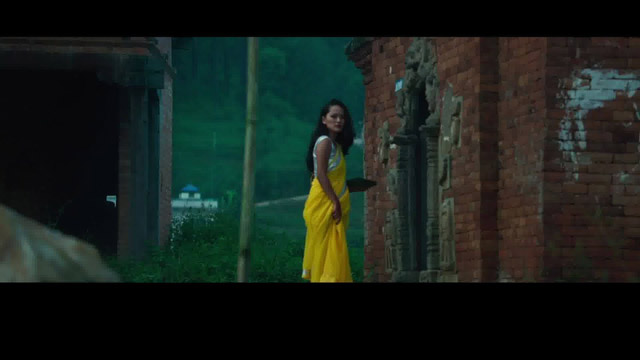
Khyentse Norbu’s ‘Looking for a Lady with Fangs and a Moustache’
Finding Yourself Through Film
[dropcap] F[/dropcap]or those of us fed a constant diet of Hollywood and Bollywood escapist fare, Khyentse Norbu’s ‘Looking for a Lady with Fangs and a Moustache’ is more than a mere film. Right from its visually challenging title, it makes you think, it makes you a bit uncomfortable and it takes you into the realm of life and death. This little gem shows you that life has to be lived fully, with an open heart.
[dropcap]S[/dropcap]et in the gorgeous beauty of Kathmandu, the film follows Tenzin, a young modern Tibetan entrepreneur totally involved in setting up a European-style coffee shop in an abandoned temple. He is all about success and places no value on the past, skeptical about mystical beliefs, scorning them as superstition. Yet when he starts having recurring hallucinations about a young woman in a poppy field and even sees his dead sister in a dream, he is unnerved and shaken, His friend Jachung takes him to a Buddhist monk for consultation and he is given a chilling verdict – these are omens of his impending death. The monk calmly predicts that Tenzin will be dead within 7 days unless he finds a dakini – a spiritual being who is the embodiment of women empowerment – who alone can save him.
He is told to find a woman with fangs, a moustache and a third eye – and when he finds her he must offer her a gift. If she is a genuine dakini she will offer him a gift in return. If she does not offer him a gift he must steal something from her and is also told about a secret mudra by which the dakini will reveal herself. The life of the savvy Tenzin who has no time for religious or spiritual beliefs is suddenly turned upside down – the reality and importance of his work and friends and much desired coffee shop fade away. His priorities change as he is embroiled in this race against death.
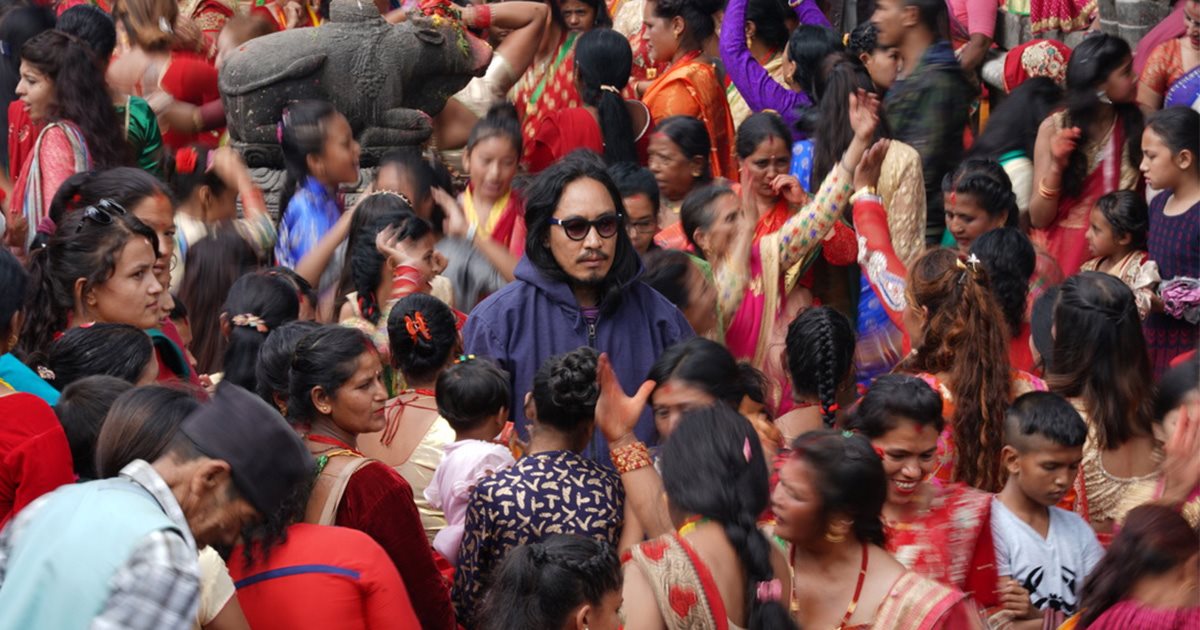
[dropcap]K[/dropcap]athmandu is full of women going about their tasks but for Tenzin the anxiety is in tracing out a true dakini amongst all these women. His hunt is angst-ridden but there is humor too as he goes about trying to find a dakini in the crowded marketplace. Can his friend Kunsel with whom he plays the lute be the one? His deadline of seven days pass in stress as he waits for death to claim him. I would not like to reveal the ending of this lovely movie – suffice it to say you learn a lot about life and death, the meaning of our existence, for the price of a movie ticket and perhaps some popcorn.
‘Looking for a Lady with Fangs and a Moustache’ comes from a master filmmaker and a master teacher of Buddhism, and the direction and story by Khyentse Norbu set it apart and tempt you to see his other films, if you haven’t seen them.
The film, which had its global premiere at the 17th Morelia International Film Festival (FICM), was also an official selection of the 2020 Tribeca Film Festival. This Nepali production, executive produced by Olivia Harrison, the widow of George Harrison.
Where you can See Looking for a Lady with Fangs and a Moustache
On April 8, 2021, The Rubin Museum of Art in New York City will host a virtual live premiere screening of LOOKING FOR A LADY WITH FANGS AND A MOUSTACHE, followed by a live conversation with the director Khyentse Norbu and Dr. Richard J. Davidson. The Global Watch Now @ Home Cinema Release will be on April 9, 2021 concurrent with some traditional in-theater engagements in Asia as circumstances allow. More information about the premiere screening, Watch Now @ Home Cinema Release, and broad TVOD availability will be available on the film’s website.
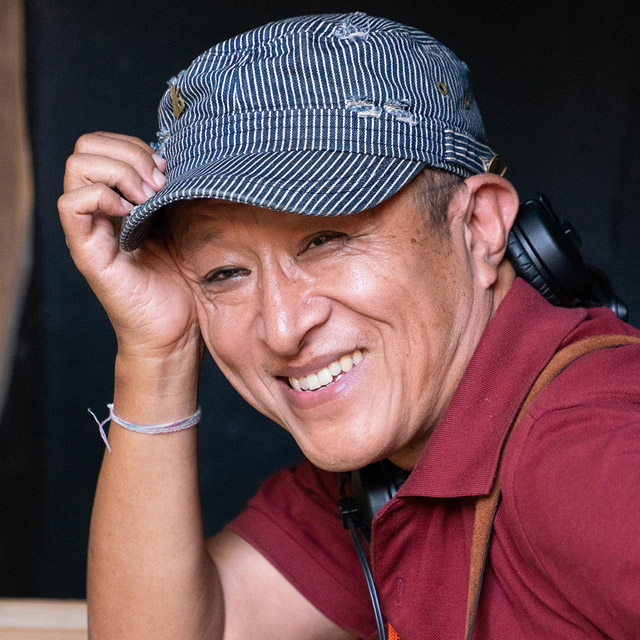
The Lassi with Lavina Interview
Khyentse Norbu Thoughts on Making ‘Looking for the Lady with Fangs and a Moustache’
“In this modern, scientific world – a world on the verge of creating artificial intelligence, and a world that disparages anything not amenable to reason – I try in this film to explore some of the last genuine residues of Tibetan mysticism.
Even among Tibetans themselves, their traditional beliefs and ways of behaving and looking at the world are increasingly rare and today carry little if any weight. And yet, I believe this ancient wisdom, which reflects the Buddhist view of reality, has something vital to offer our modern world. Especially, I intend this film to express the deep respect for feminine energy embodied in that wisdom, and to portray in a contemporary setting both the transformative power of this energy and some of the ways it has traditionally been evoked.” – Khyentse Norbu
10 Questions for Khyentse Norbu
I. A lot of people in today’s fast moving society will be able to see themselves in Tenzin – ‘modern’, skeptical and with no time for religion or spirituality. What was your motivation for making this film and what do you hope viewers will take away from it?
I like to think that there is a lot of value in exploring the world that is what we, the modern people, call superstitious, mythological, legend, or religious because time and again it has been proven that life is more meaningful than a job, and money and basically becoming a factory.
2. “Some dakinis are so close, you can’t see them – like your own eyelash.” Dakinis are an integral part of Tantric Buddhist teaching – are they a symbol of real woman power? Is there a dakini in every woman? Can she be the compassionate protector?
Yes, there is a dakini in every woman.
3. Your cast was very natural and certainly makes viewers forget it is cinema – how did you go about choosing these wonderful, slice of life actors?
For filmmakers such as myself it is impossible to find professional actors. There are many reasons for this, such as budget constraints and also not many well known actors wish to smear their reputation by appearing in a film which is not commercially successful. So I I try to type cast. I Spend time with them before the film and during the film, not only talking about the story itself but really talking about the paradox of life. These things may have helped.
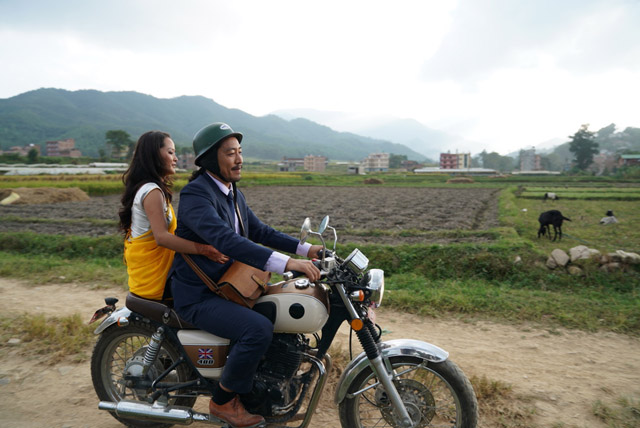
5. Both in Nepal and India, superstition, myths and spirituality live side by side with modernity, technology and westernization. As a Buddhist teacher how do you think ordinary people can walk a fine line between the two and still lead a balanced, meaningful life?
It is not a question of whether people can walk a fine line between myth and the so called modern world with things such as technology; it is simply a matter whether you have the will to do it. I personally think just becoming a slave to technology and the web of social system is a loss of meaning in our lives.
6. There is a wonderful underlying humor to life as conveyed in your film, be it the headphone twirling monk who proclaims ‘Cereal may be my last obstacle to enlightenment’ or the colorful, benign scene of a bride’s wedding to a dog to offset any bad omens for her future. How does Buddhism make the hard facts of life easier to bear with its gentleness, compassion and love?
I think the Buddhist fundamental belief that it is through fiction that one can tell the truth therefore not disregarding and devaluing so called superstition, myth and stories can be very compassionate and loving.
7. In this modern, materialistic world are your iconic films yet another way for you to teach people about why we are all here?
I hope so – I would not claim myself as one.
8. What gives you the most pleasure in creating cinema?
Just the simple idea that you can portray a life within a frame, and if you can manage to do it is very rewarding and even sometimes liberating.
9. Having lived in India, how connected do you feel to the country and what are your favorite places there?
Even though I’m not Indian I feel culturally and spiritually very connected to India.
10. As a filmmaker and a Buddhist teacher, what gets you through the ups and downs of life?
I don’t personally see contradiction between a film maker and a Buddhist teacher. Film making is just a medium. If I don’t know how to use the medium, then it doesn’t matter whether it is a film or whether it is a typewriter I will not be able to make full use of its potential.
So who is Khyentse Norbu?
[dropcap]K[/dropcap]nown in the Buddhist world as Dzongsar Khyentse Rinpoche, Norbu brings to his films a profound and subtle mastery and under- standing of Buddhist philosophy and practice. He studied and trained with some of the leading Tibetan Buddhist masters of the 20th century, graduated from secular schools in India and Europe, and teaches Buddhism on five continents. He is the author of several books on following the Buddhist path in the contemporary world, including the best- selling What Makes You Not a Buddhist.
Khyentse Norbu also oversees the non-profit organizations Siddhartha’s Intent, Khyentse Foundation, 84000, and Lotus Outreach as well as contemporary teaching and practice centers in different parts of the world. He is responsible for the care and education of 1,600 monks in six monasteries and institutes in Asia and is head of Dzongsar Monastery and College in Tibet, Dzongsar Khyentse Institute in India, and Chökyi Gyatso Institute for Buddhist Studies in Bhutan.
Norbu’s first film, The Cup (1999), became an international sensation after its premiere screening at the Cannes Film Festival’s prestigious Director’s Fortnight. It went on to win critical acclaim and official selections at major festivals worldwide, including Sundance, Hong Kong, London, and Moscow. It won awards at four international festivals, including an International Federation of Film Critics (FIPRESCI) award at Busan and an audience award at the Toronto International Film Festival. Norbu’s second film, Travellers & Magicians (2003), was the first full-length feature film shot in the Hima-layan Kingdom of Bhutan. It premiered at the Venice International Film Festival.
His third feature film, Vara: A Blessing (2013), based on a short story by Bengali author Sunil Gangopadhyay and filmed in Sri Lanka, won the Best Feature Film award at the Tribeca Online Film Festival. Hema Hema: Sing Me a Song While I Wait (2016), Norbu’s fourth feature film. Shot in remote parts of Bhutan, the film won the audience choice award at the 2016 Golden Global Awards at the Malaysian International Film Festival and honorable mention at the 2016 Toronto International Film Festival.
(Additional text courtesy: Khyentse Norbu – Abramorama Films)
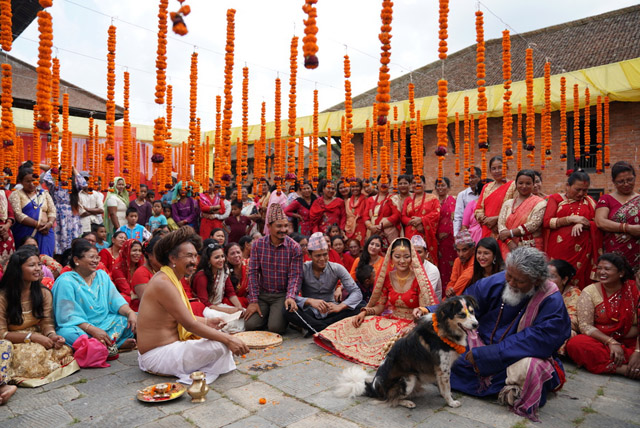
From the Director’s Chair: Storytelling the Himalayan Way
[dropcap]”B[/dropcap]ecause it brings together so dramatically these modern and ancient worlds, I felt Nepal to be an ideal setting for this film. Besides the mountains and trekking for which it is popularly known, Nepal is a very spiritual and magical place, and I want to capture that quality both through the eyes of local inhabitants and in the way the film is shot.
For example, I will give the audience plenty of time for contemplation, so images may not move fast and may even stand still for a period. As well, I want to catch the magical qualities of life through the eyes of a character who is really panicked, which we’ll do by using hand-held cameras. It’s precisely because this film will evoke contemplation that I wanted to work with the Director of Photography Mark Lee Ping Bing. I have always had the highest respect for his sensitivity, contemplative style, and amazing capacity to capture images..
I used only non-professional actors, not only because – unlike in the west – there are few trained actors in Nepal, but also because the characters I am trying to portray have to be really genuine. For example, one of the characters is portrayed by an actual highly respected spiritual master whose qualities and demeanor a hundred thousand trained actors could not fathom let alone convey.
Sadly, these days, we see everything from fashion and consumer goods to storytelling, books and films increasingly produced according to set formulae that are proven to “sell the product.” Though few films today escape the enormous influence of the Hollywood and Bollywood formulae, I want to explore in this film a distinctive Himalayan way of expression and storytelling that is true to this region’s culture, tradition and wisdom. In such ways, and through its atmosphere and techniques, I hope this film will transport audiences to a profound, mystical, and yet very real and accessible dimension of life with which our modern world is sadly and rapidly losing touch.”
